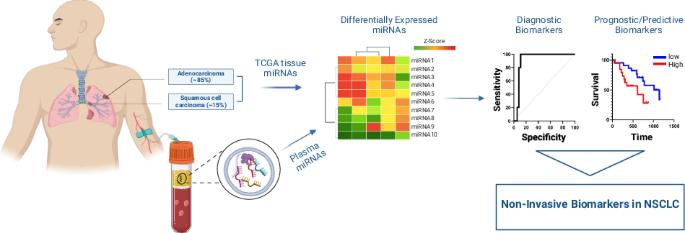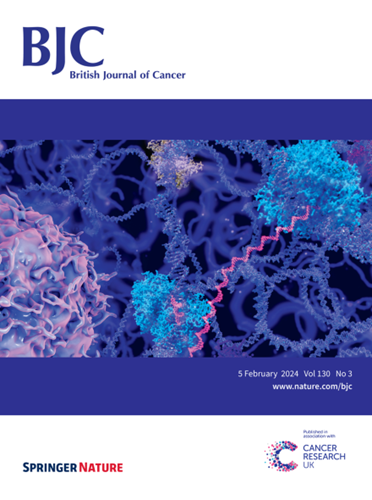Circulating miRNA panels as a novel non-invasive diagnostic, prognostic, and potential predictive biomarkers in non-small cell lung cancer (NSCLC)
IF 6.4
1区 医学
Q1 ONCOLOGY
引用次数: 0
Abstract
Non-small cell lung cancer (NSCLC) is characterised by its aggressiveness and poor prognosis. Early detection and accurate prediction of therapeutic responses remain critical for improving patient outcomes. In the present study, we investigated the potential of circulating microRNA (miRNA) as non-invasive biomarkers in patients with NSCLC. We quantified miRNA expression in plasma from 122 participants (78 NSCLC; 44 healthy controls). Bioinformatic tools were employed to identify miRNA panels for accurate NSCLC diagnosis. Validation was performed using an independent publicly available dataset of more than 4000 NSCLC patients. Next, we correlated miRNA expression with clinicopathological information to identify independent prognostic miRNAs and those predictive of anti-PD-1 treatment response. We identified miRNA panels for lung adenocarcinoma (LUAD) and squamous cell carcinoma (LUSC) diagnosis. The LUAD panel consists of seven circulating miRNAs (miR-9-3p, miR-96-5p, miR-147b-3p, miR-196a-5p, miR-708-3p, miR-708-5p, miR-4652-5p), while the LUSC panel comprises nine miRNAs (miR-130b-3p, miR-269-3p, miR-301a-5p, miR-301b-5p, miR-744-3p, miR-760, miR-767-5p, miR-4652-5p, miR-6499-3p). Additionally, miR-135b-5p, miR-196a-5p, miR-31-5p (LUAD), and miR-205 (LUSC) serve as independent prognostic markers for survival. Furthermore, two miRNA clusters, namely miR-183/96/182 and miR-767/105, exhibit predictive potential in anti-PD-1-treated LUAD patients. Circulating miRNA signatures demonstrate diagnostic and prognostic value for NSCLC and may guide treatment decisions in clinical practice.


将循环 miRNA 组作为非小细胞肺癌 (NSCLC) 的新型非侵入性诊断、预后和潜在预测生物标记物。
背景:非小细胞肺癌(NSCLC)的特点是侵袭性强、预后差。早期检测和准确预测治疗反应对于改善患者预后至关重要。在本研究中,我们探讨了循环微RNA(miRNA)作为NSCLC患者非侵入性生物标志物的潜力:我们对 122 名参与者(78 名 NSCLC 患者;44 名健康对照者)血浆中的 miRNA 表达进行了量化。采用生物信息学工具确定了用于准确诊断 NSCLC 的 miRNA 组。我们使用一个独立的公开数据集对 4000 多名 NSCLC 患者进行了验证。接下来,我们将 miRNA 表达与临床病理信息相关联,以确定独立的预后 miRNA 和可预测抗 PD-1 治疗反应的 miRNA:结果:我们确定了肺腺癌(LUAD)和鳞状细胞癌(LUSC)诊断的 miRNA 面板。LUAD 面板由七个循环 miRNA 组成(miR-9-3p、miR-96-5p、miR-147b-3p、miR-196a-5p、miR-708-3p、miR-708-5p、miR-4652-5p)、而 LUSC 面板包括 9 个 miRNA(miR-130b-3p、miR-269-3p、miR-301a-5p、miR-301b-5p、miR-744-3p、miR-760、miR-767-5p、miR-4652-5p、miR-6499-3p)。此外,miR-135b-5p、miR-196a-5p、miR-31-5p(LUAD)和miR-205(LUSC)是影响生存的独立预后标志物。此外,两个miRNA群,即miR-183/96/182和miR-767/105,对抗PD-1治疗的LUAD患者具有预测潜力:循环 miRNA 特征对 NSCLC 具有诊断和预后价值,可在临床实践中指导治疗决策。
本文章由计算机程序翻译,如有差异,请以英文原文为准。
求助全文
约1分钟内获得全文
求助全文
来源期刊

British Journal of Cancer
医学-肿瘤学
CiteScore
15.10
自引率
1.10%
发文量
383
审稿时长
6 months
期刊介绍:
The British Journal of Cancer is one of the most-cited general cancer journals, publishing significant advances in translational and clinical cancer research.It also publishes high-quality reviews and thought-provoking comment on all aspects of cancer prevention,diagnosis and treatment.
 求助内容:
求助内容: 应助结果提醒方式:
应助结果提醒方式:


